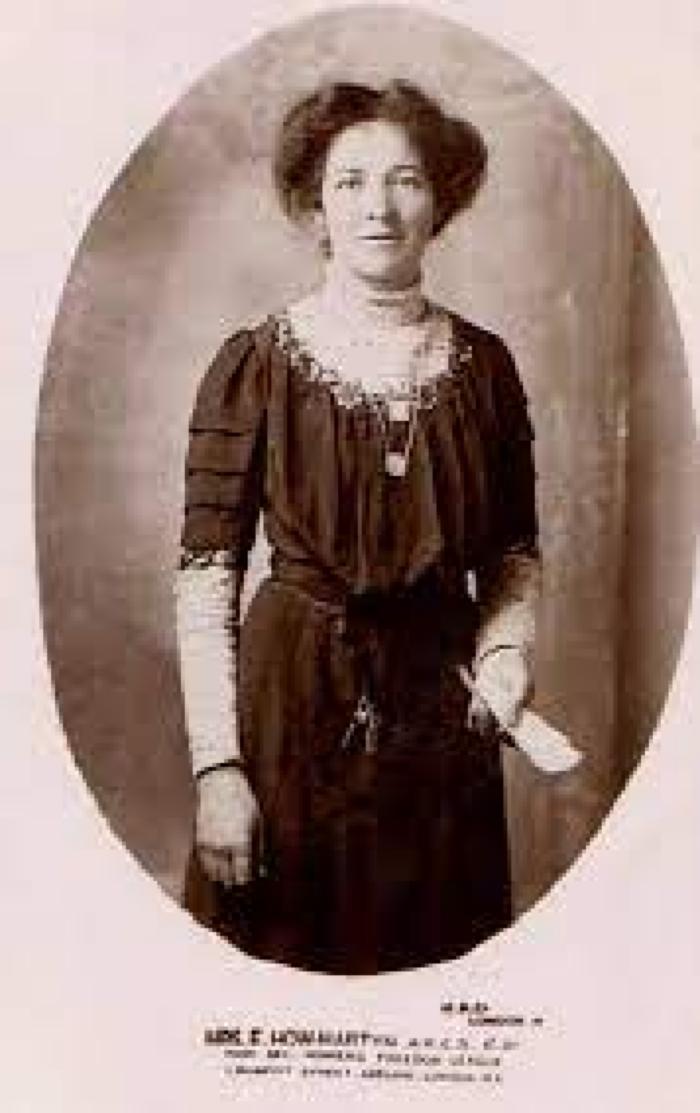Overview of Edith How-Martyn
 She lived at 38 Hogarth Hill
She lived at 38 Hogarth Hill
Born Edith How in Middlesex in 1875, died Australia in 1954.
Attended North London Collegiate School, then University College, Aberystwyth studying Mathematics and Physics. Received external BSc from London University in 1903 (most universities did not award degrees to women. Was a Mathematics lecturer but gave up to campaign for votes for women.
Married George Herbert Martyn in 1899 and they adopted a shared surname: How Martyn
Initially belonged to the WSPU in which she had a senior role: was joint Honorary Secretary (with Charlotte Despard).
She was one of the first suffragettes to be imprisoned in 1906 for “scuffling with police” when trying to make a speech in the lobby of House of Commons – this was one of first acts of suffragette militancy. She served one month in Holloway.
In 1907 she left the WSPU and was a leader and co-founder of the Women’s Freedom League (WFL), due to concerns about the lack of democracy in the WSPU and opposition to violent acts. The WFL was still a ‘militant’ suffragette organization, but only advocated non-violent illegal acts (influenced by Mahatma Gandhi).
She was involved in actions designed to attract publicity for the WFL, for example an attempt to disrupt the King’s procession to the February 1909 opening of Parliament. Muriel Matters hired a small dirigible (airship) which took off from Hendon airfield, aiming to drop leaflets over the procession and Parliament. The wind took the dirigible elsewhere, but 25kg of leaflets were dropped from the balloon which had the slogans “Votes for Women” and “Women’s Freedom League” on it. This attracted significant press coverage (see images). Edith How Martyn was ‘support crew’, driving her car in pursuit of the balloon.
 Edith How-Martyn was Honorary Secretary of the WFL and edited ‘The Vote’, the WFL weekly newspaper.
Edith How-Martyn was Honorary Secretary of the WFL and edited ‘The Vote’, the WFL weekly newspaper.
In 1911 she became Head of WFL’s Political and Militant Department. Her first action was to organise a boycott the 1911 Census. She went to urge women to join together in an act of civil disobedience: ‘… to boycott the census, to refuse all information about themselves and their households… We intend to do our best to make it unreliable and inaccurate.’
Although initiated by the WFL, the WSPU soon joined the campaign, recognising the potential for publicity. In addition to the boycott itself, there were numerous public meetings to support the campaign, including one on the eve of the census where Edith How Martyn spoke in Trafalgar Square.
She and her husband did not complete the census form, but Edith wrote:
“No votes for women. No information from women.”
“Legislation without Representation is slavery.”
“The occupier of this house is not a person only a woman. See decision of House of Lords Scottish Graduates Case 1908.”